HSC230 Cultural Safety in Healthcare: Mind Map and Written Reflection
VerifiedAdded on 2023/01/10
|10
|1859
|66
Homework Assignment
AI Summary
This assignment presents a student's mind map and written reflection on personal values, beliefs, and behaviors in the context of healthcare, specifically addressing cultural safety. The student explores values such as selflessness, integrity, and respect, linking them to professional practice and patient care. The reflection delves into personal beliefs, including religious background, dietary considerations, and the importance of patient autonomy in treatment choices. Behaviors such as exercise, humor, compassion, and active listening are also examined for their impact on creating a culturally safe environment. The assignment emphasizes the importance of understanding and accommodating diverse cultural backgrounds to foster positive therapeutic relationships and improve patient outcomes. The student utilizes peer-reviewed literature to support their analysis and demonstrates an understanding of cultural safety principles within a multicultural healthcare setting. The assignment aims to promote self-reflection and professional development to enhance the quality of care provided to patients.
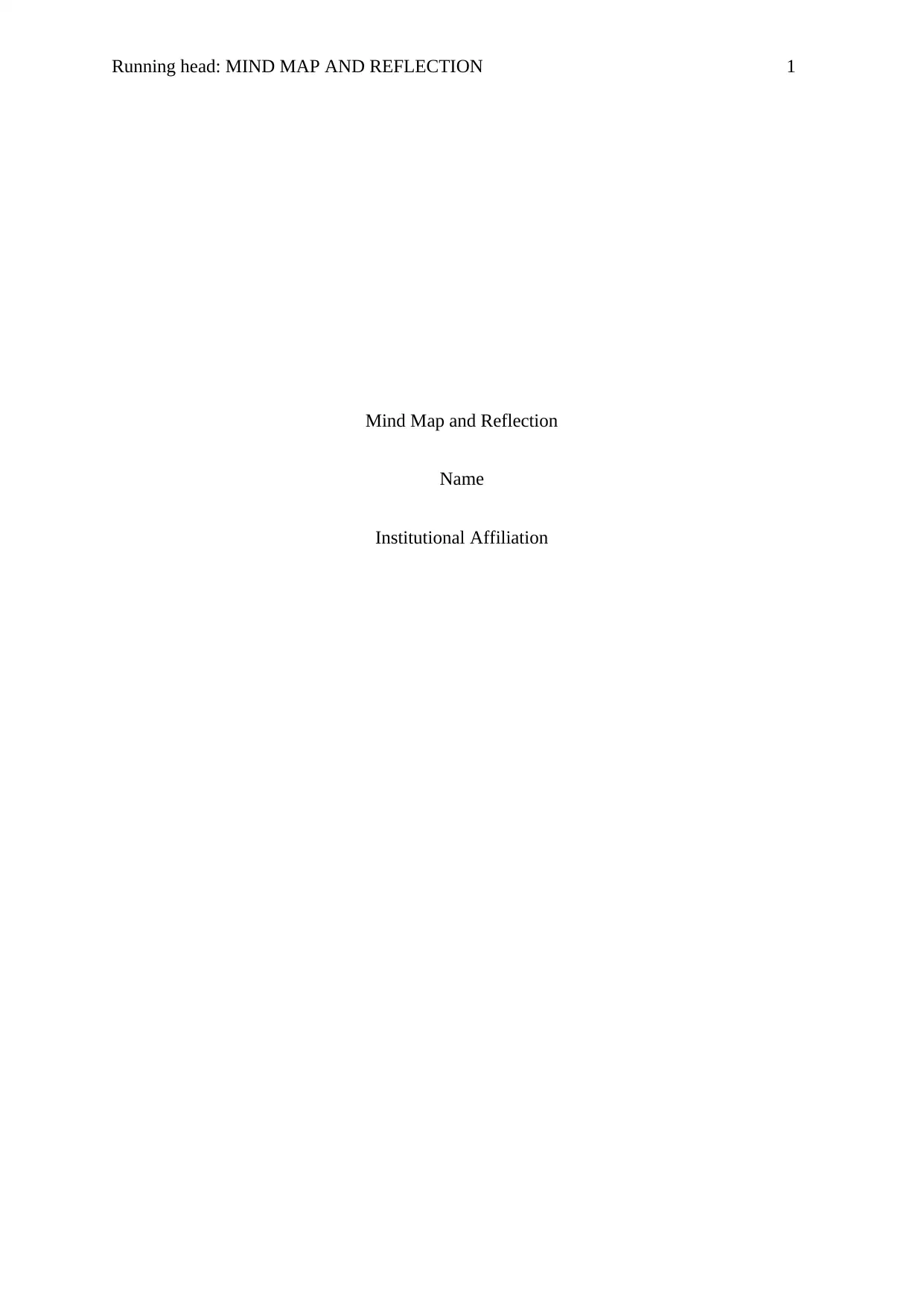
Running head: MIND MAP AND REFLECTION 1
Mind Map and Reflection
Name
Institutional Affiliation
Mind Map and Reflection
Name
Institutional Affiliation
Paraphrase This Document
Need a fresh take? Get an instant paraphrase of this document with our AI Paraphraser
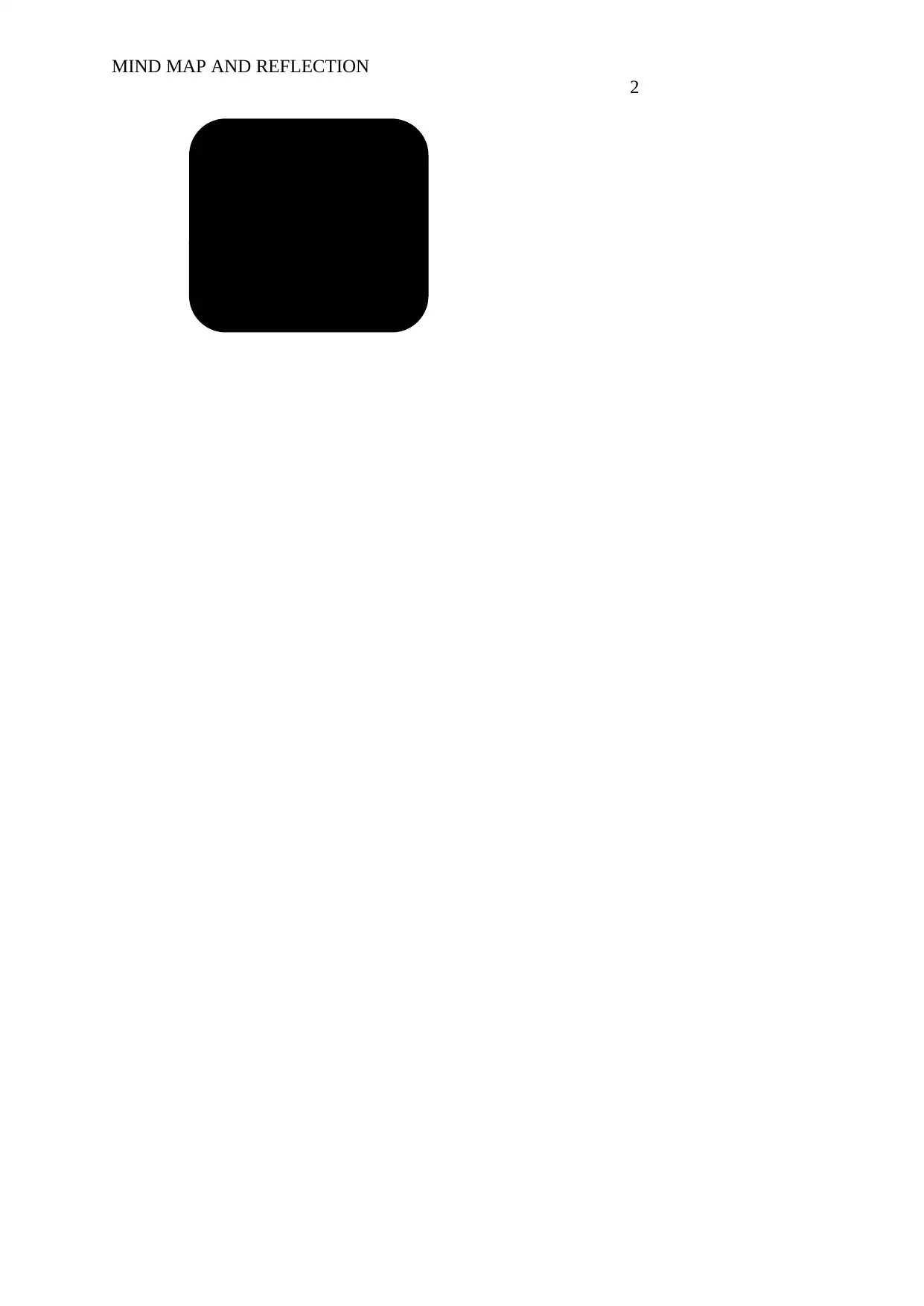
MIND MAP AND REFLECTION
2
2
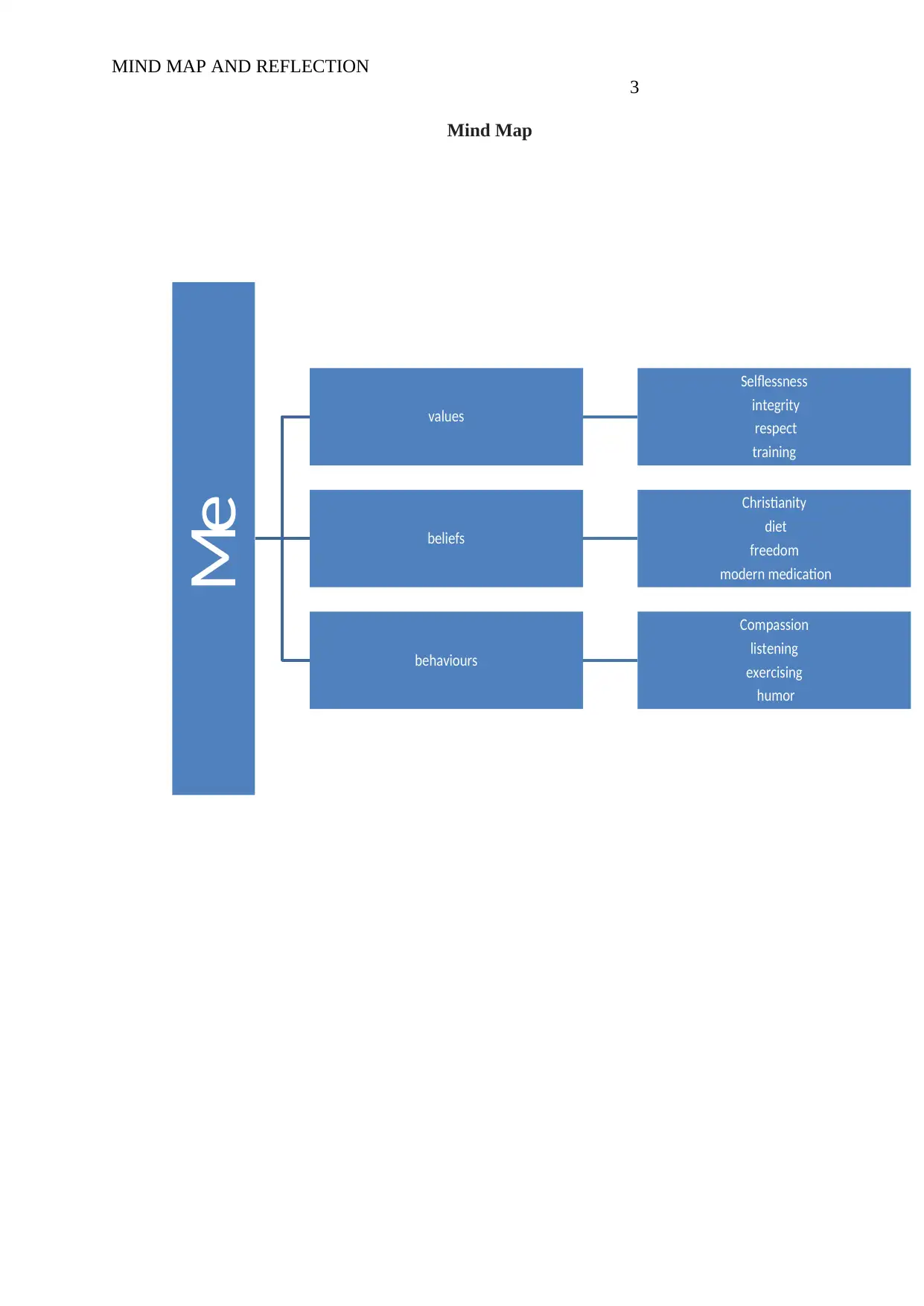
MIND MAP AND REFLECTION
3
Mind Map
Me
values
Selflessness
integrity
respect
training
beliefs
Christianity
diet
freedom
modern medication
behaviours
Compassion
listening
exercising
humor
3
Mind Map
Me
values
Selflessness
integrity
respect
training
beliefs
Christianity
diet
freedom
modern medication
behaviours
Compassion
listening
exercising
humor
⊘ This is a preview!⊘
Do you want full access?
Subscribe today to unlock all pages.

Trusted by 1+ million students worldwide
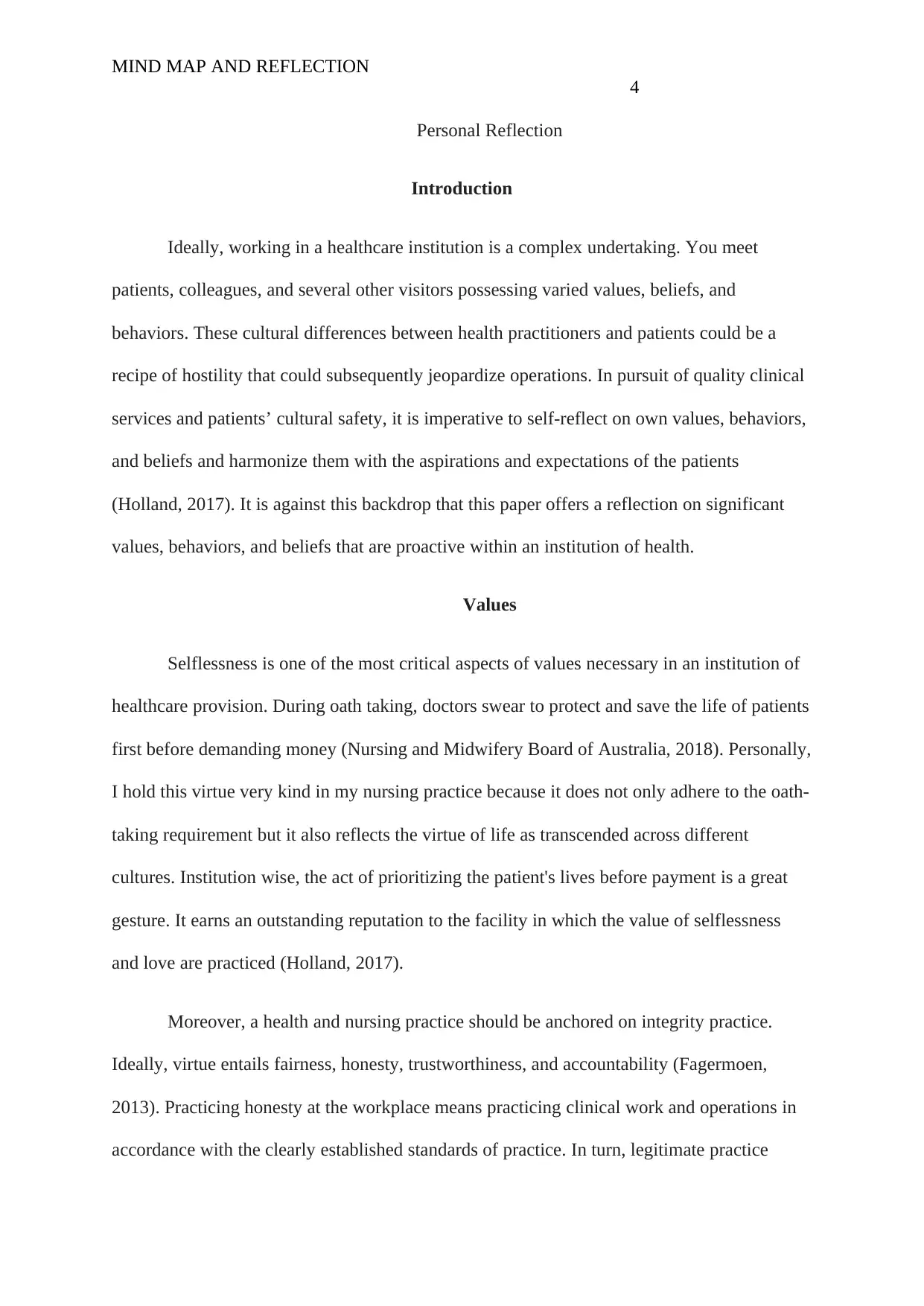
MIND MAP AND REFLECTION
4
Personal Reflection
Introduction
Ideally, working in a healthcare institution is a complex undertaking. You meet
patients, colleagues, and several other visitors possessing varied values, beliefs, and
behaviors. These cultural differences between health practitioners and patients could be a
recipe of hostility that could subsequently jeopardize operations. In pursuit of quality clinical
services and patients’ cultural safety, it is imperative to self-reflect on own values, behaviors,
and beliefs and harmonize them with the aspirations and expectations of the patients
(Holland, 2017). It is against this backdrop that this paper offers a reflection on significant
values, behaviors, and beliefs that are proactive within an institution of health.
Values
Selflessness is one of the most critical aspects of values necessary in an institution of
healthcare provision. During oath taking, doctors swear to protect and save the life of patients
first before demanding money (Nursing and Midwifery Board of Australia, 2018). Personally,
I hold this virtue very kind in my nursing practice because it does not only adhere to the oath-
taking requirement but it also reflects the virtue of life as transcended across different
cultures. Institution wise, the act of prioritizing the patient's lives before payment is a great
gesture. It earns an outstanding reputation to the facility in which the value of selflessness
and love are practiced (Holland, 2017).
Moreover, a health and nursing practice should be anchored on integrity practice.
Ideally, virtue entails fairness, honesty, trustworthiness, and accountability (Fagermoen,
2013). Practicing honesty at the workplace means practicing clinical work and operations in
accordance with the clearly established standards of practice. In turn, legitimate practice
4
Personal Reflection
Introduction
Ideally, working in a healthcare institution is a complex undertaking. You meet
patients, colleagues, and several other visitors possessing varied values, beliefs, and
behaviors. These cultural differences between health practitioners and patients could be a
recipe of hostility that could subsequently jeopardize operations. In pursuit of quality clinical
services and patients’ cultural safety, it is imperative to self-reflect on own values, behaviors,
and beliefs and harmonize them with the aspirations and expectations of the patients
(Holland, 2017). It is against this backdrop that this paper offers a reflection on significant
values, behaviors, and beliefs that are proactive within an institution of health.
Values
Selflessness is one of the most critical aspects of values necessary in an institution of
healthcare provision. During oath taking, doctors swear to protect and save the life of patients
first before demanding money (Nursing and Midwifery Board of Australia, 2018). Personally,
I hold this virtue very kind in my nursing practice because it does not only adhere to the oath-
taking requirement but it also reflects the virtue of life as transcended across different
cultures. Institution wise, the act of prioritizing the patient's lives before payment is a great
gesture. It earns an outstanding reputation to the facility in which the value of selflessness
and love are practiced (Holland, 2017).
Moreover, a health and nursing practice should be anchored on integrity practice.
Ideally, virtue entails fairness, honesty, trustworthiness, and accountability (Fagermoen,
2013). Practicing honesty at the workplace means practicing clinical work and operations in
accordance with the clearly established standards of practice. In turn, legitimate practice
Paraphrase This Document
Need a fresh take? Get an instant paraphrase of this document with our AI Paraphraser
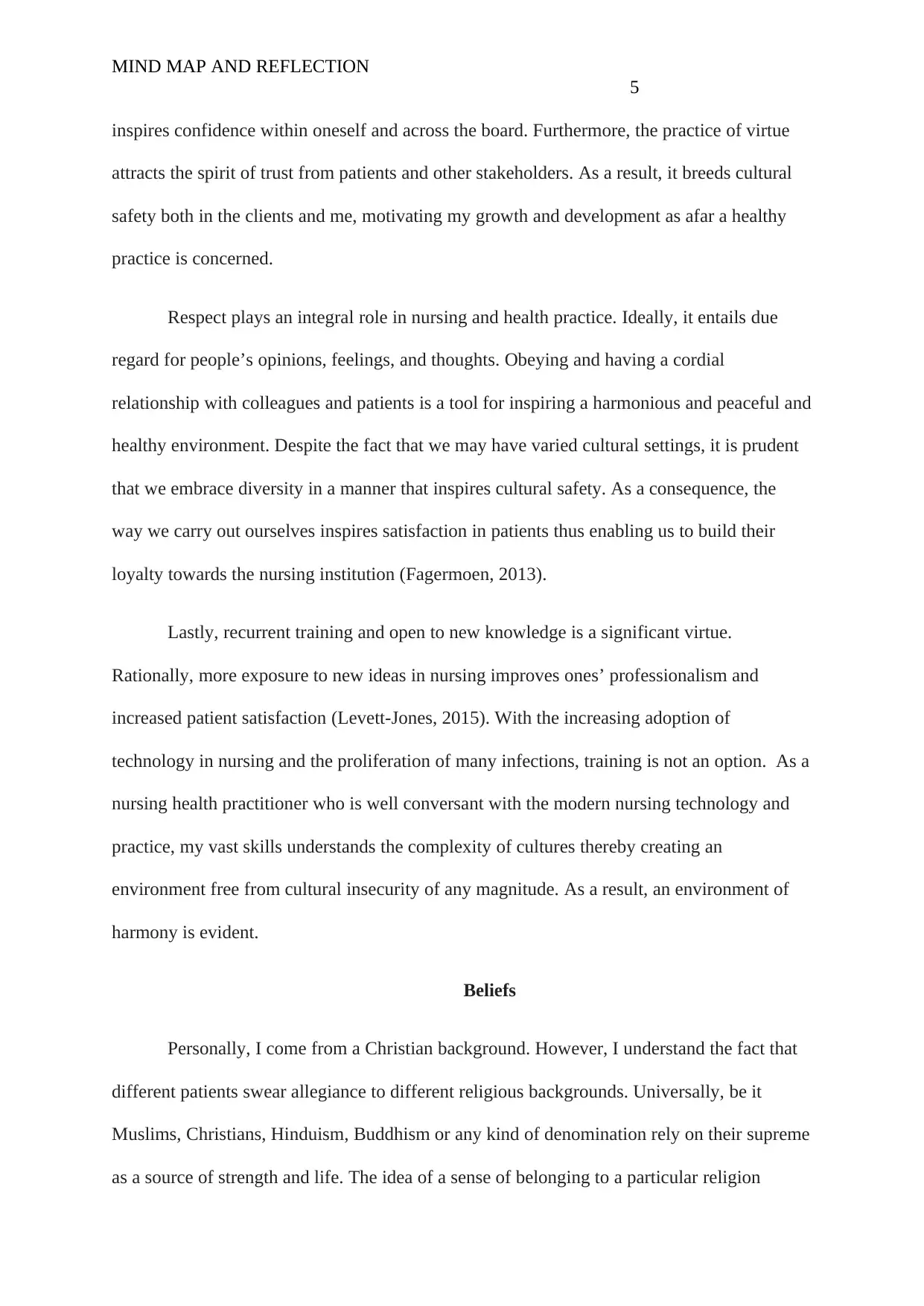
MIND MAP AND REFLECTION
5
inspires confidence within oneself and across the board. Furthermore, the practice of virtue
attracts the spirit of trust from patients and other stakeholders. As a result, it breeds cultural
safety both in the clients and me, motivating my growth and development as afar a healthy
practice is concerned.
Respect plays an integral role in nursing and health practice. Ideally, it entails due
regard for people’s opinions, feelings, and thoughts. Obeying and having a cordial
relationship with colleagues and patients is a tool for inspiring a harmonious and peaceful and
healthy environment. Despite the fact that we may have varied cultural settings, it is prudent
that we embrace diversity in a manner that inspires cultural safety. As a consequence, the
way we carry out ourselves inspires satisfaction in patients thus enabling us to build their
loyalty towards the nursing institution (Fagermoen, 2013).
Lastly, recurrent training and open to new knowledge is a significant virtue.
Rationally, more exposure to new ideas in nursing improves ones’ professionalism and
increased patient satisfaction (Levett-Jones, 2015). With the increasing adoption of
technology in nursing and the proliferation of many infections, training is not an option. As a
nursing health practitioner who is well conversant with the modern nursing technology and
practice, my vast skills understands the complexity of cultures thereby creating an
environment free from cultural insecurity of any magnitude. As a result, an environment of
harmony is evident.
Beliefs
Personally, I come from a Christian background. However, I understand the fact that
different patients swear allegiance to different religious backgrounds. Universally, be it
Muslims, Christians, Hinduism, Buddhism or any kind of denomination rely on their supreme
as a source of strength and life. The idea of a sense of belonging to a particular religion
5
inspires confidence within oneself and across the board. Furthermore, the practice of virtue
attracts the spirit of trust from patients and other stakeholders. As a result, it breeds cultural
safety both in the clients and me, motivating my growth and development as afar a healthy
practice is concerned.
Respect plays an integral role in nursing and health practice. Ideally, it entails due
regard for people’s opinions, feelings, and thoughts. Obeying and having a cordial
relationship with colleagues and patients is a tool for inspiring a harmonious and peaceful and
healthy environment. Despite the fact that we may have varied cultural settings, it is prudent
that we embrace diversity in a manner that inspires cultural safety. As a consequence, the
way we carry out ourselves inspires satisfaction in patients thus enabling us to build their
loyalty towards the nursing institution (Fagermoen, 2013).
Lastly, recurrent training and open to new knowledge is a significant virtue.
Rationally, more exposure to new ideas in nursing improves ones’ professionalism and
increased patient satisfaction (Levett-Jones, 2015). With the increasing adoption of
technology in nursing and the proliferation of many infections, training is not an option. As a
nursing health practitioner who is well conversant with the modern nursing technology and
practice, my vast skills understands the complexity of cultures thereby creating an
environment free from cultural insecurity of any magnitude. As a result, an environment of
harmony is evident.
Beliefs
Personally, I come from a Christian background. However, I understand the fact that
different patients swear allegiance to different religious backgrounds. Universally, be it
Muslims, Christians, Hinduism, Buddhism or any kind of denomination rely on their supreme
as a source of strength and life. The idea of a sense of belonging to a particular religion
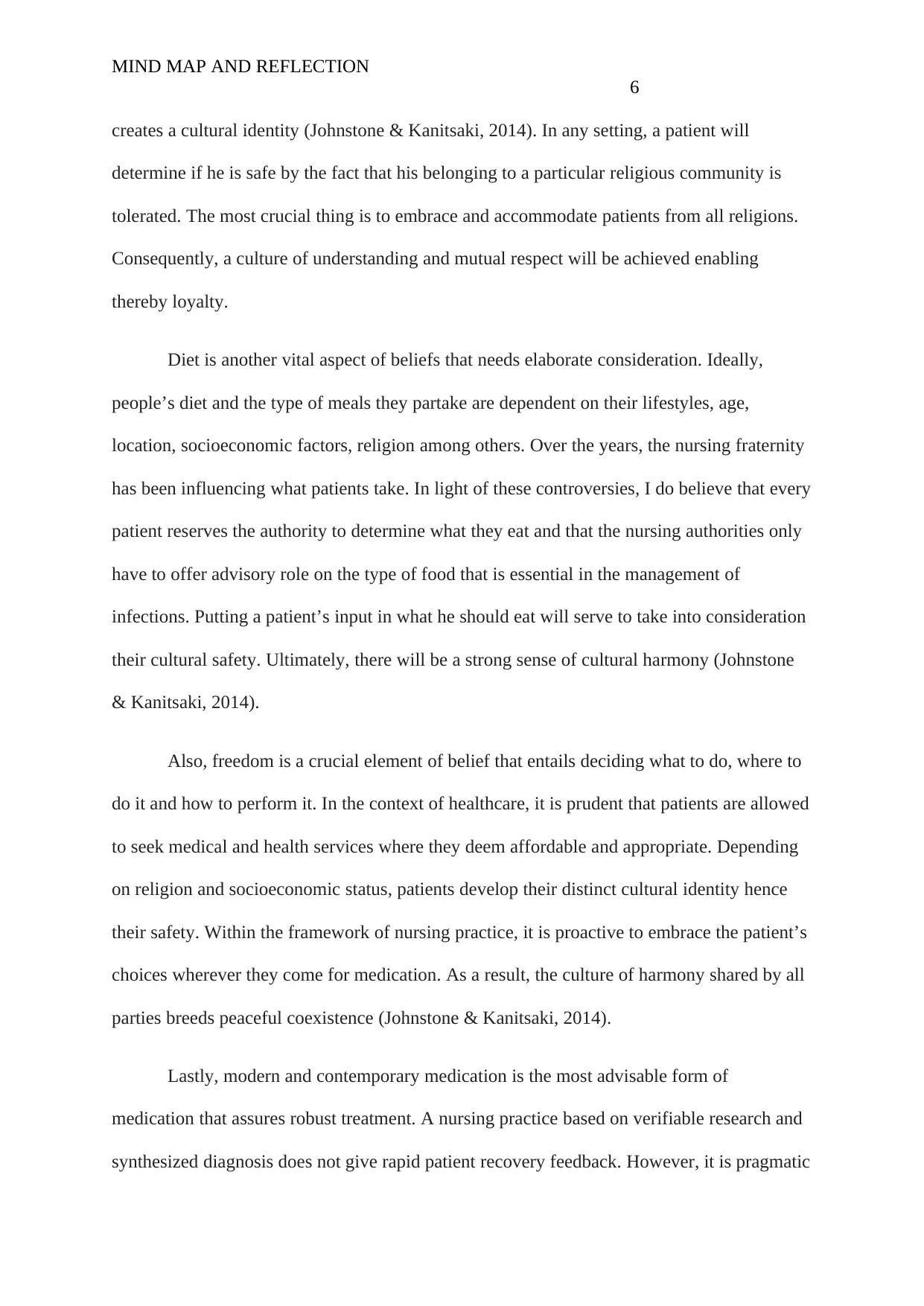
MIND MAP AND REFLECTION
6
creates a cultural identity (Johnstone & Kanitsaki, 2014). In any setting, a patient will
determine if he is safe by the fact that his belonging to a particular religious community is
tolerated. The most crucial thing is to embrace and accommodate patients from all religions.
Consequently, a culture of understanding and mutual respect will be achieved enabling
thereby loyalty.
Diet is another vital aspect of beliefs that needs elaborate consideration. Ideally,
people’s diet and the type of meals they partake are dependent on their lifestyles, age,
location, socioeconomic factors, religion among others. Over the years, the nursing fraternity
has been influencing what patients take. In light of these controversies, I do believe that every
patient reserves the authority to determine what they eat and that the nursing authorities only
have to offer advisory role on the type of food that is essential in the management of
infections. Putting a patient’s input in what he should eat will serve to take into consideration
their cultural safety. Ultimately, there will be a strong sense of cultural harmony (Johnstone
& Kanitsaki, 2014).
Also, freedom is a crucial element of belief that entails deciding what to do, where to
do it and how to perform it. In the context of healthcare, it is prudent that patients are allowed
to seek medical and health services where they deem affordable and appropriate. Depending
on religion and socioeconomic status, patients develop their distinct cultural identity hence
their safety. Within the framework of nursing practice, it is proactive to embrace the patient’s
choices wherever they come for medication. As a result, the culture of harmony shared by all
parties breeds peaceful coexistence (Johnstone & Kanitsaki, 2014).
Lastly, modern and contemporary medication is the most advisable form of
medication that assures robust treatment. A nursing practice based on verifiable research and
synthesized diagnosis does not give rapid patient recovery feedback. However, it is pragmatic
6
creates a cultural identity (Johnstone & Kanitsaki, 2014). In any setting, a patient will
determine if he is safe by the fact that his belonging to a particular religious community is
tolerated. The most crucial thing is to embrace and accommodate patients from all religions.
Consequently, a culture of understanding and mutual respect will be achieved enabling
thereby loyalty.
Diet is another vital aspect of beliefs that needs elaborate consideration. Ideally,
people’s diet and the type of meals they partake are dependent on their lifestyles, age,
location, socioeconomic factors, religion among others. Over the years, the nursing fraternity
has been influencing what patients take. In light of these controversies, I do believe that every
patient reserves the authority to determine what they eat and that the nursing authorities only
have to offer advisory role on the type of food that is essential in the management of
infections. Putting a patient’s input in what he should eat will serve to take into consideration
their cultural safety. Ultimately, there will be a strong sense of cultural harmony (Johnstone
& Kanitsaki, 2014).
Also, freedom is a crucial element of belief that entails deciding what to do, where to
do it and how to perform it. In the context of healthcare, it is prudent that patients are allowed
to seek medical and health services where they deem affordable and appropriate. Depending
on religion and socioeconomic status, patients develop their distinct cultural identity hence
their safety. Within the framework of nursing practice, it is proactive to embrace the patient’s
choices wherever they come for medication. As a result, the culture of harmony shared by all
parties breeds peaceful coexistence (Johnstone & Kanitsaki, 2014).
Lastly, modern and contemporary medication is the most advisable form of
medication that assures robust treatment. A nursing practice based on verifiable research and
synthesized diagnosis does not give rapid patient recovery feedback. However, it is pragmatic
⊘ This is a preview!⊘
Do you want full access?
Subscribe today to unlock all pages.

Trusted by 1+ million students worldwide
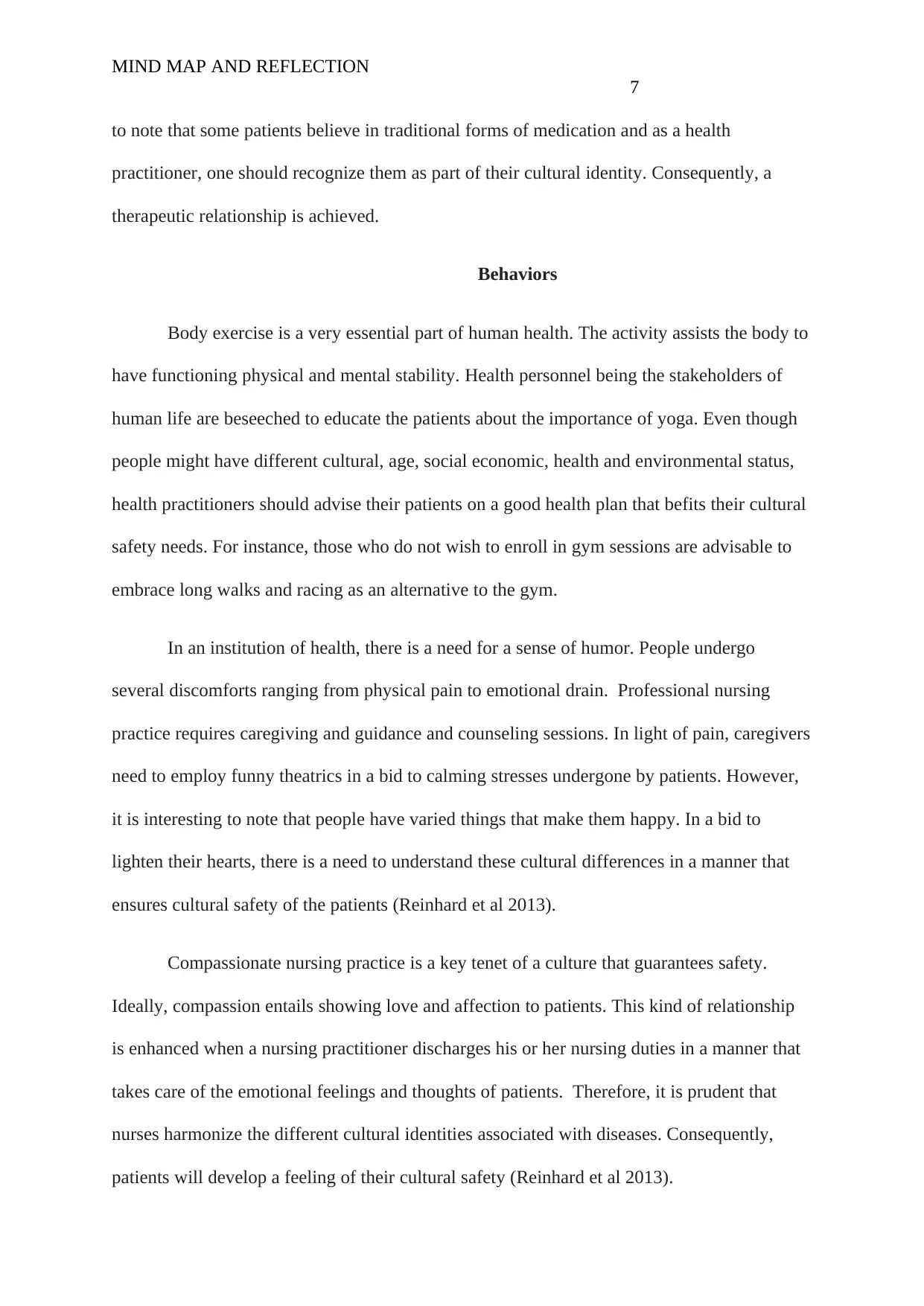
MIND MAP AND REFLECTION
7
to note that some patients believe in traditional forms of medication and as a health
practitioner, one should recognize them as part of their cultural identity. Consequently, a
therapeutic relationship is achieved.
Behaviors
Body exercise is a very essential part of human health. The activity assists the body to
have functioning physical and mental stability. Health personnel being the stakeholders of
human life are beseeched to educate the patients about the importance of yoga. Even though
people might have different cultural, age, social economic, health and environmental status,
health practitioners should advise their patients on a good health plan that befits their cultural
safety needs. For instance, those who do not wish to enroll in gym sessions are advisable to
embrace long walks and racing as an alternative to the gym.
In an institution of health, there is a need for a sense of humor. People undergo
several discomforts ranging from physical pain to emotional drain. Professional nursing
practice requires caregiving and guidance and counseling sessions. In light of pain, caregivers
need to employ funny theatrics in a bid to calming stresses undergone by patients. However,
it is interesting to note that people have varied things that make them happy. In a bid to
lighten their hearts, there is a need to understand these cultural differences in a manner that
ensures cultural safety of the patients (Reinhard et al 2013).
Compassionate nursing practice is a key tenet of a culture that guarantees safety.
Ideally, compassion entails showing love and affection to patients. This kind of relationship
is enhanced when a nursing practitioner discharges his or her nursing duties in a manner that
takes care of the emotional feelings and thoughts of patients. Therefore, it is prudent that
nurses harmonize the different cultural identities associated with diseases. Consequently,
patients will develop a feeling of their cultural safety (Reinhard et al 2013).
7
to note that some patients believe in traditional forms of medication and as a health
practitioner, one should recognize them as part of their cultural identity. Consequently, a
therapeutic relationship is achieved.
Behaviors
Body exercise is a very essential part of human health. The activity assists the body to
have functioning physical and mental stability. Health personnel being the stakeholders of
human life are beseeched to educate the patients about the importance of yoga. Even though
people might have different cultural, age, social economic, health and environmental status,
health practitioners should advise their patients on a good health plan that befits their cultural
safety needs. For instance, those who do not wish to enroll in gym sessions are advisable to
embrace long walks and racing as an alternative to the gym.
In an institution of health, there is a need for a sense of humor. People undergo
several discomforts ranging from physical pain to emotional drain. Professional nursing
practice requires caregiving and guidance and counseling sessions. In light of pain, caregivers
need to employ funny theatrics in a bid to calming stresses undergone by patients. However,
it is interesting to note that people have varied things that make them happy. In a bid to
lighten their hearts, there is a need to understand these cultural differences in a manner that
ensures cultural safety of the patients (Reinhard et al 2013).
Compassionate nursing practice is a key tenet of a culture that guarantees safety.
Ideally, compassion entails showing love and affection to patients. This kind of relationship
is enhanced when a nursing practitioner discharges his or her nursing duties in a manner that
takes care of the emotional feelings and thoughts of patients. Therefore, it is prudent that
nurses harmonize the different cultural identities associated with diseases. Consequently,
patients will develop a feeling of their cultural safety (Reinhard et al 2013).
Paraphrase This Document
Need a fresh take? Get an instant paraphrase of this document with our AI Paraphraser
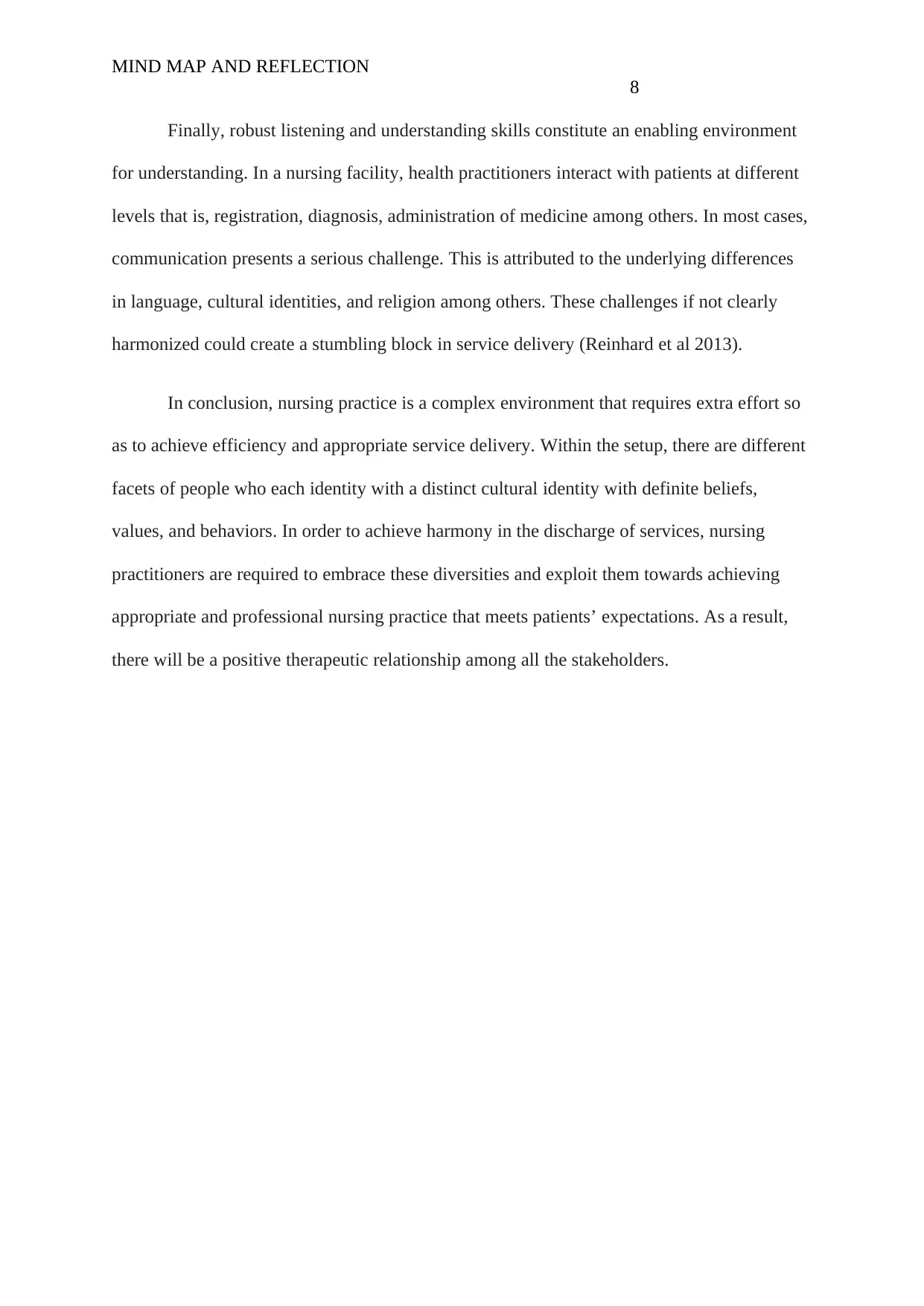
MIND MAP AND REFLECTION
8
Finally, robust listening and understanding skills constitute an enabling environment
for understanding. In a nursing facility, health practitioners interact with patients at different
levels that is, registration, diagnosis, administration of medicine among others. In most cases,
communication presents a serious challenge. This is attributed to the underlying differences
in language, cultural identities, and religion among others. These challenges if not clearly
harmonized could create a stumbling block in service delivery (Reinhard et al 2013).
In conclusion, nursing practice is a complex environment that requires extra effort so
as to achieve efficiency and appropriate service delivery. Within the setup, there are different
facets of people who each identity with a distinct cultural identity with definite beliefs,
values, and behaviors. In order to achieve harmony in the discharge of services, nursing
practitioners are required to embrace these diversities and exploit them towards achieving
appropriate and professional nursing practice that meets patients’ expectations. As a result,
there will be a positive therapeutic relationship among all the stakeholders.
8
Finally, robust listening and understanding skills constitute an enabling environment
for understanding. In a nursing facility, health practitioners interact with patients at different
levels that is, registration, diagnosis, administration of medicine among others. In most cases,
communication presents a serious challenge. This is attributed to the underlying differences
in language, cultural identities, and religion among others. These challenges if not clearly
harmonized could create a stumbling block in service delivery (Reinhard et al 2013).
In conclusion, nursing practice is a complex environment that requires extra effort so
as to achieve efficiency and appropriate service delivery. Within the setup, there are different
facets of people who each identity with a distinct cultural identity with definite beliefs,
values, and behaviors. In order to achieve harmony in the discharge of services, nursing
practitioners are required to embrace these diversities and exploit them towards achieving
appropriate and professional nursing practice that meets patients’ expectations. As a result,
there will be a positive therapeutic relationship among all the stakeholders.
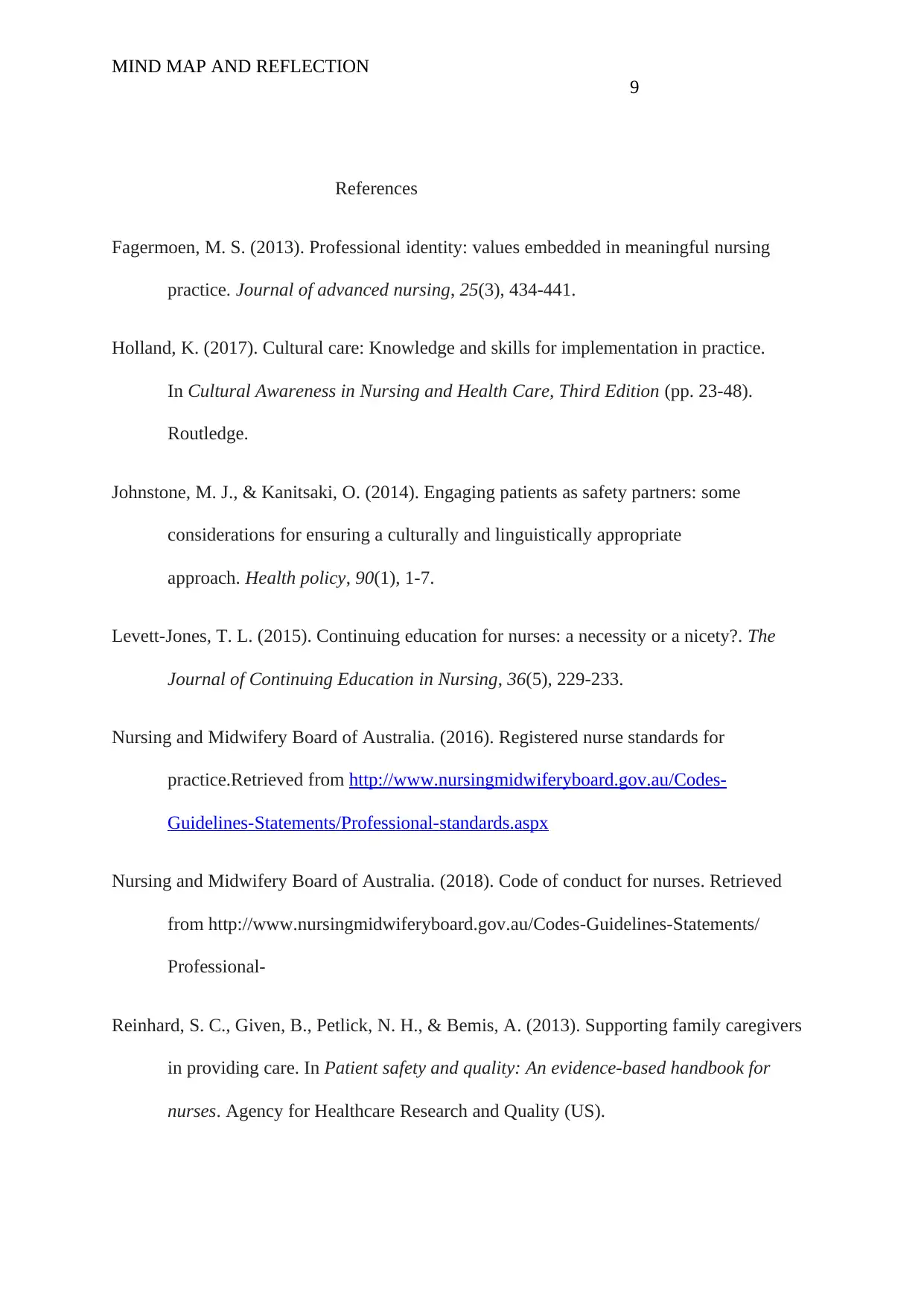
MIND MAP AND REFLECTION
9
References
Fagermoen, M. S. (2013). Professional identity: values embedded in meaningful nursing
practice. Journal of advanced nursing, 25(3), 434-441.
Holland, K. (2017). Cultural care: Knowledge and skills for implementation in practice.
In Cultural Awareness in Nursing and Health Care, Third Edition (pp. 23-48).
Routledge.
Johnstone, M. J., & Kanitsaki, O. (2014). Engaging patients as safety partners: some
considerations for ensuring a culturally and linguistically appropriate
approach. Health policy, 90(1), 1-7.
Levett-Jones, T. L. (2015). Continuing education for nurses: a necessity or a nicety?. The
Journal of Continuing Education in Nursing, 36(5), 229-233.
Nursing and Midwifery Board of Australia. (2016). Registered nurse standards for
practice.Retrieved from http://www.nursingmidwiferyboard.gov.au/Codes-
Guidelines-Statements/Professional-standards.aspx
Nursing and Midwifery Board of Australia. (2018). Code of conduct for nurses. Retrieved
from http://www.nursingmidwiferyboard.gov.au/Codes-Guidelines-Statements/
Professional-
Reinhard, S. C., Given, B., Petlick, N. H., & Bemis, A. (2013). Supporting family caregivers
in providing care. In Patient safety and quality: An evidence-based handbook for
nurses. Agency for Healthcare Research and Quality (US).
9
References
Fagermoen, M. S. (2013). Professional identity: values embedded in meaningful nursing
practice. Journal of advanced nursing, 25(3), 434-441.
Holland, K. (2017). Cultural care: Knowledge and skills for implementation in practice.
In Cultural Awareness in Nursing and Health Care, Third Edition (pp. 23-48).
Routledge.
Johnstone, M. J., & Kanitsaki, O. (2014). Engaging patients as safety partners: some
considerations for ensuring a culturally and linguistically appropriate
approach. Health policy, 90(1), 1-7.
Levett-Jones, T. L. (2015). Continuing education for nurses: a necessity or a nicety?. The
Journal of Continuing Education in Nursing, 36(5), 229-233.
Nursing and Midwifery Board of Australia. (2016). Registered nurse standards for
practice.Retrieved from http://www.nursingmidwiferyboard.gov.au/Codes-
Guidelines-Statements/Professional-standards.aspx
Nursing and Midwifery Board of Australia. (2018). Code of conduct for nurses. Retrieved
from http://www.nursingmidwiferyboard.gov.au/Codes-Guidelines-Statements/
Professional-
Reinhard, S. C., Given, B., Petlick, N. H., & Bemis, A. (2013). Supporting family caregivers
in providing care. In Patient safety and quality: An evidence-based handbook for
nurses. Agency for Healthcare Research and Quality (US).
⊘ This is a preview!⊘
Do you want full access?
Subscribe today to unlock all pages.

Trusted by 1+ million students worldwide
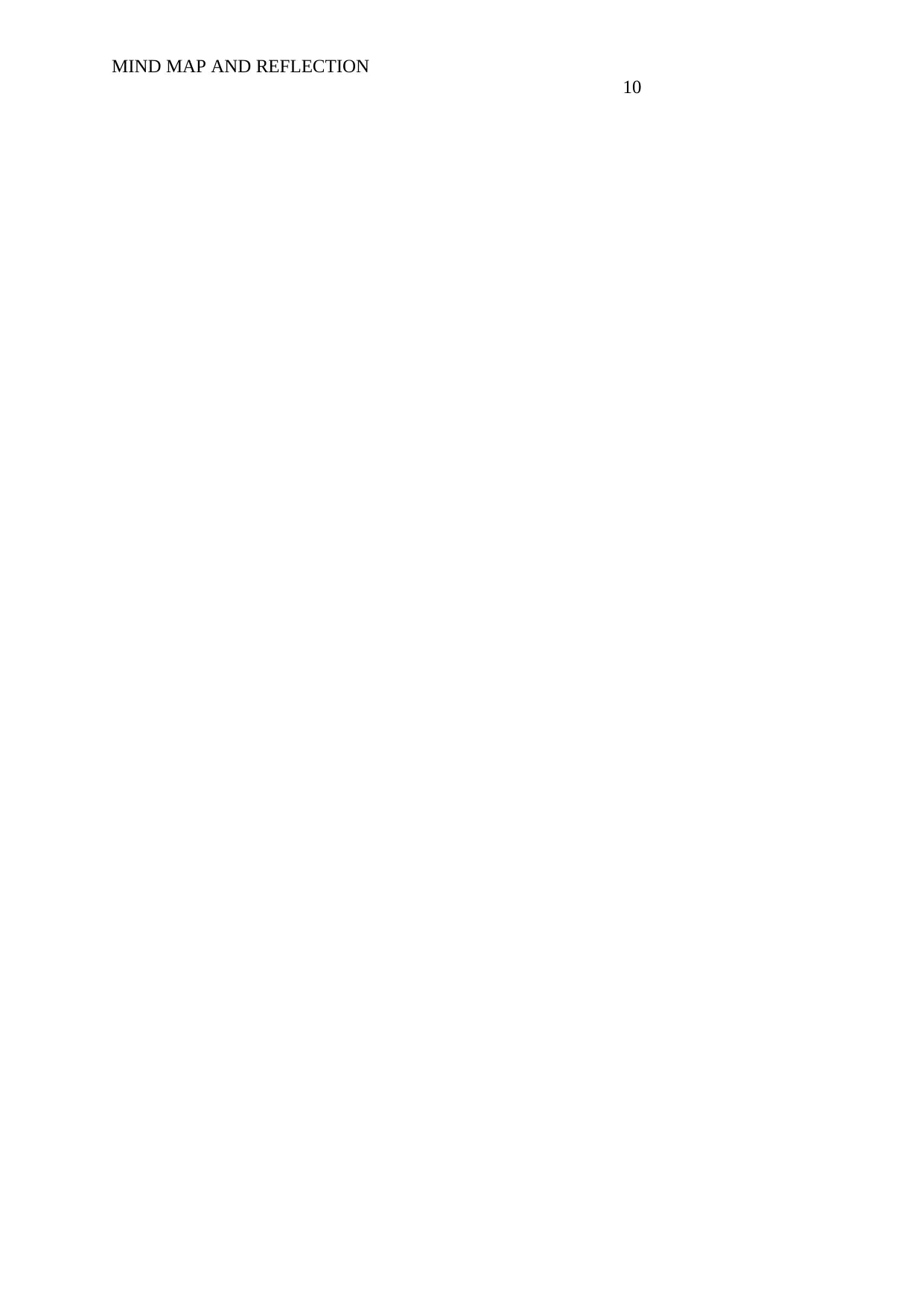
MIND MAP AND REFLECTION
10
10
1 out of 10
Related Documents
Your All-in-One AI-Powered Toolkit for Academic Success.
+13062052269
info@desklib.com
Available 24*7 on WhatsApp / Email
![[object Object]](/_next/static/media/star-bottom.7253800d.svg)
Unlock your academic potential
Copyright © 2020–2025 A2Z Services. All Rights Reserved. Developed and managed by ZUCOL.





